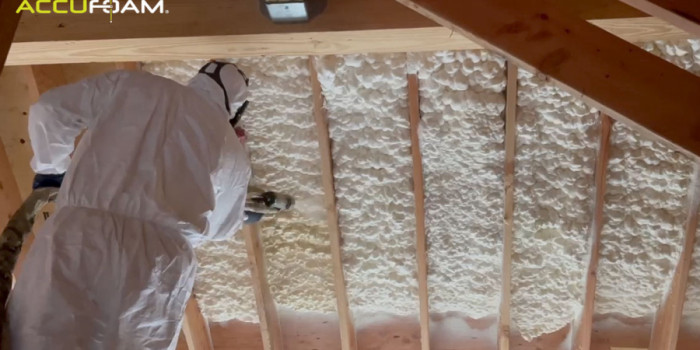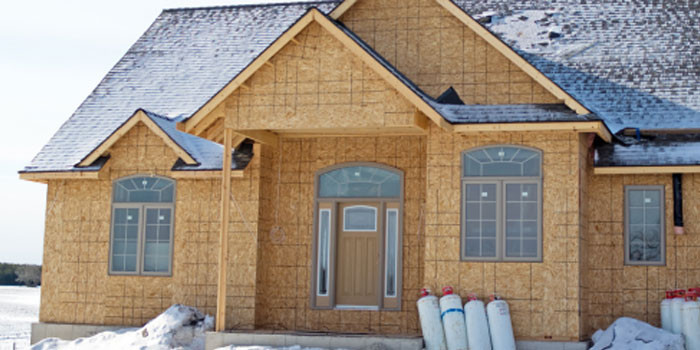A Winning Combination
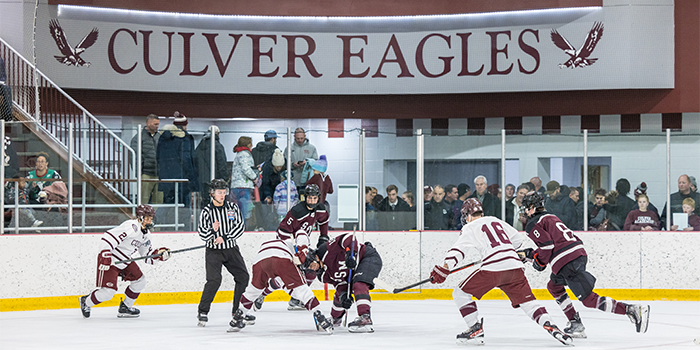

Spray Foam Magazine – An hour south of South Bend, Indiana, along the northern edge of Lake Maxinkuckee, you’ll find Culver Academies, a prestigious college preparatory boarding school. Culver Academies’ campus includes three separate schools - Culver Military Academy for boys, Culver Girls Academy, and the Culver Summer Schools & Camps. Culver Academies boasts a rich history of famous alumni, including New York Yankees owner George Steinbrenner, recording artist Dierks Bentley, movie critic Gene Siskel, and even Crown Prince Alexander of Yugoslavia. Molly Engstrom, who attended the Culver Girls Academy, won bronze and silver Olympic Medals with the US Women’s Hockey team in 2006 and 2010, respectively, and Culver Academies’ Henderson Ice Arena is where she learned to skate and shoot like a pro.
Henderson Ice Arena is also where spray foam insulation recently provided the solution to a unique issue: the almost constant formation of bumps and ripples on the frozen surface of the ice rink.
Henderson Ice Arena is a facility comprised of two world class hockey rinks, an NHL-size rink named Henderson-Clark, and an Olympic-size rink named Henderson-Perin, as well as a weight room, full service athletic training room, locker rooms, and a pre/post game event lounge. The Arena is used year-round, home to four Culver Military Academy teams and two Culver Girls Academy teams, and doubles as a multipurpose practice facility for other sports and activities for the Culver Summer Schools and Camps. Built in 1976, the facility had received regular periodic updates to its systems. However, in the last few years, the Henderson-Clark rink had gone from an 8-month operation cycle to a 12-month operation cycle, which put additional strain on the mechanical systems and greatly increased an existing condensation issue due to use in the hotter, more humid summer months.
Rene Chapdelaine, Rink Manager and professional hockey player from 1989-2003, described the issue in detail, “Water droplets fell from the arena ceiling like a light rain, freezing on the ice and causing bumps and ripples on the surface. The boards were constantly sweating, creating small ice formations along the base of the walls, which required 2 hours of daily maintenance to chip the excess ice away.” To keep the ice in smooth playable condition, the Culver Zamboni, which is appropriately painted in the style of a Sherman tank, had to employ a special cross-cut pattern which added an additional 2 hours to the process. Said Rene, “In all, we were using an extra 3-4 hours of manpower per day to keep the ice smooth.” Rene had an idea that the building’s insulation, or lack thereof, could be the culprit. Together with Culver Director of Facilities, Brent Colvin, a plan to upgrade the Arenas’ building systems was created. They called the local insulation expert, Kyle Hoover of The Insulation Guys in Rochester, IN, to investigate. Kyle and his team are the trusted insulation partner for the Academy, having upgraded the insulation of campus homestead houses used by professors.
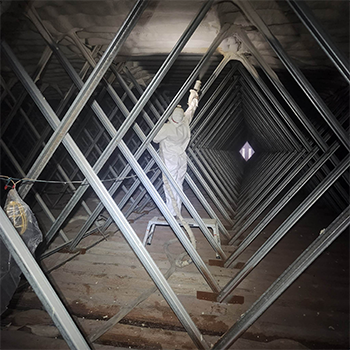
Very little insulation was left from the original 70’s install. The Insulation Guys installed four inches of GacoONEPass closed-cell spray foam on the roof deck and walls of the Arena attic.
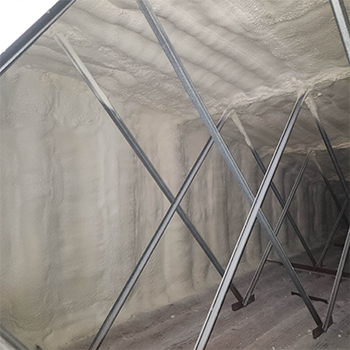
When Kyle examined the attic of the Arena, he made a surprising discovery. “We found old 3lb. foam that had been installed in the 1970’s at about 1 ½ in. thickness”, said Kyle, “Because the almost 50 year old insulation did not benefit from modern advancements in spray foam formulation, it had not weathered the years well.” Kyle found huge gaps in insulation coverage, and adding to the problem was the fact that the entire attic space was vented, allowing outside air to flow inside. The arena below uses air conditioning and dehumidification to keep a constant temperature of 50 degrees. On warmer humid days in spring, summer, and early fall, the warm humid air in the attic met the colder conditioned air below, creating the perfect conditions for heavy condensation, and a forecast for freezing rain on the ice rink.
Kyle knew spray foam was the answer and called in Aaron Davenport, Director of Building Science at Holcim Building Envelope, manufacturer of Gaco|SES Spray Foam products, for his input on the issue. “With both the environmental conditions inside the ice rink and the seasonal Indiana weather contributing to the issues”, Aaron determined, “The best course of action would be sealing the attic roof deck and walls with four inches of GacoONEPass closed cell spray foam.” GacoONEPass is an industry leading closed cell foam, favored for its ability to be sprayed four inches thick with a smooth even surface in a single pass. Unlike other spray foam insulation, GacoONEPass is a low VOC, low odor product that won’t leave a bad smell inside the arena. Once applied to the roof deck and walls of the Arena’s attic space, GacoONEPass would create a monolithic air, thermal, and moisture seal across the top of the building. It would also reinforce the structure of the facility by adding racking strength to the roof for periods of heavy snowfall. With this approach, warm humid air would be sealed off from the attic, eliminating the interaction with the colder air below and solving the issue of water droplets disrupting the ice rink’s smooth surface.
With the solution in hand, it was time to get to work.
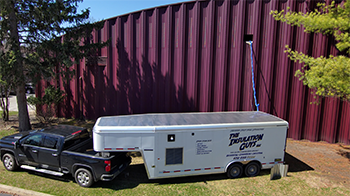
The Insulation Guys cut a hole in a gable end to allow 300 feet of hose to reach across the attic.
Once the attic was cleaned and ready for install, The Insulation Guys started applying four inches of GacoONEPass closed cell spray foam on the roof deck. Because the massive 212-foot-long attic was vented at each gable end, Kyle and his team were easily able to follow their Confined Space Safety Protocols, utilizing large fans to provide ample ventilation for the workers, who also used approved personal protection equipment during installation. Hose length from the rig to the spray foam gun was a challenge, solved by cutting a hole at one of the gable ends to allow a 300’ hose to reach all necessary surfaces. Special attention was also needed to avoid damage to the myriad of metal cross members supporting the cylindrical roof.
The Insulation Guys team spent a total of 3 ½ weeks on the job, and benefited from the high yield of GacoONEPass, getting 5000 board feet out of each set and reducing their planned material needs from 35 sets to 33. The Arena roof deck and walls were completely covered, creating the desired monolithic air, thermal, and moisture barrier, and instantly solving the condensation issue. Rene commented, “We are already putting the ice back in the arena and have noticed a big difference in the space compared to the past. When you walk in the building, it’s more comfortable, it’s quiet.”
Generally speaking, the energy savings of spray foam insulation is the primary driver for building owners to choose GacoONEPass closed cell spray foam, but in this case, it was an added benefit. Brent expects a future energy audit to show great improvements in thermal performance. “We believe the spray foam insulation of the Henderson-Clark rink will be a substantial improvement to the overall function of the rink’s environment. This should translate into improved efficiencies throughout the building, less time spent dressing the ice, and improved man-hours overall.”
Coupled with the planned mechanical system upgrades, Brent and the Culver Academies can expect lower bills related to heating and cooling costs, and future generations of the Culver Academy Eagles can enjoy a smooth surface for slapshots between the pipes.
Contact SES Polyurethane Systems
If you have any questions about any of SES’s products or services: 713-239-0252 // www.sesfoam.com
*Spray Foam Magazine does not take editorial positions on particular issues; individual contributions to the magazine express the opinions of discrete authors unless explicitly labeled or otherwise stated. The inclusion of a particular piece in the magazine does not mean that individual staff members or editors concur with the editorial positions represented therein.
For use by SprayFoamMagazine.com & Spray Foam Magazine
Disqus website name not provided.






